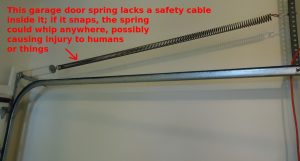Most homeowners who have a garage door, either new or old, may not know what a torsion spring repair or even an extension spring is for that matter. While you don’t have to know what these parts are knowing what they do can be imperative to diagnosing an issue with the garage door. It can also help you understand when to call a garage door repair service before the garage door suddenly stops working.
Since both springs are responsible for managing the counterbalance system of the garage door, a problem with either one can cause your garage door to stop working. The counterbalance system for those who don’t know uses a system of force to offset the overall weight of the door, which allows it to easily be raised and then lowered. The counterweight is managed by either an extension or a torsion spring depending on the make and model of the garage door.
The Difference Between Torsion and Extension Springs
Even though there are many different types of springs that can be used in the counterbalance system, the two most widely used are torsion and extension springs.
Torsion Springs: These happen to be the most common types of springs found in modern garage doors. They are available in various lengths and sizes that are based on the garage door’s track radius, weight, and height. Larger versions of the spring are installed on the top from where they may operate the sliding mechanism which lifts the door via the attached cables. Torsion springs will wind and unwind to raise and lower the door respectively. Generally, torsion springs are more expensive but also more durable. They move the door steadier and because of that, the garage door opener does not have to work very hard.
Extension Springs: These are an older technology but still common mainly because they are cheap and best suited for lighter consequently smaller garage doors. They don’t occupy a lot of overhead space because they are on the side as opposed to on top of the garage door. The drawback to extension springs is that they operate the garage door with a jerking motion, and that translates to more wear and tear. There have been cases of the spring snapping and causing injuries.

Image Credit Wikimedia Commons
What Does All This Mean for You?
Well, for starters, if you are in the market for a garage door, try buying one with a torsion spring as opposed to one with an extension spring. Make sure that you check the spring’s rated number of cycles and the warranty. The more cycles the better.
If you are buying a smaller garage door with a low budget extension springs may be acceptable. But check with the manufacturer as to what safety mechanisms are installed to prevent the door from injuring the user in the event the spring snaps. Many manufacturers have a safety hinge in place, which should prevent the door from causing personal injuries if the spring snaps. So, always hire a professional garage door company.










Leave A Comment